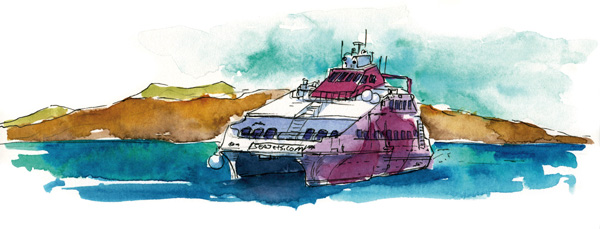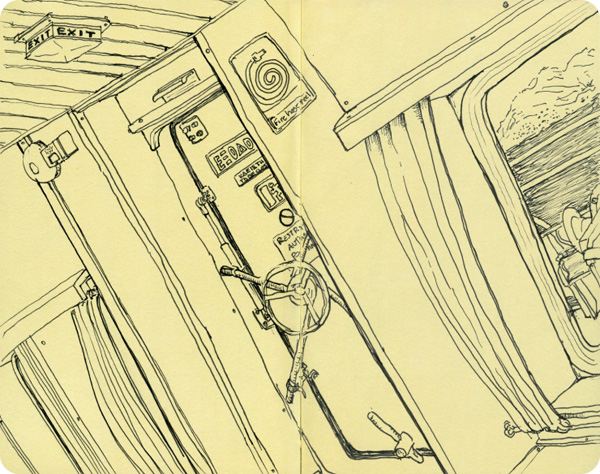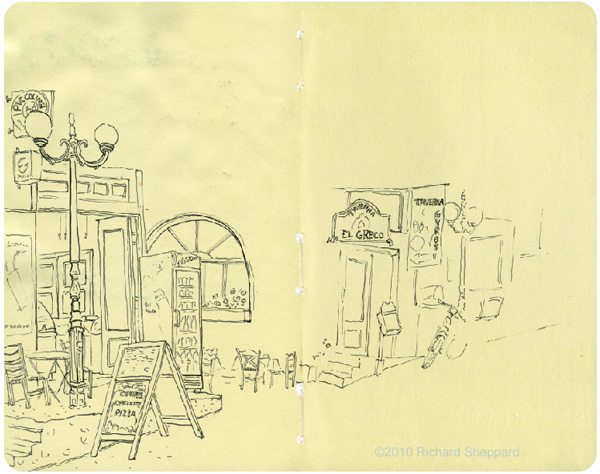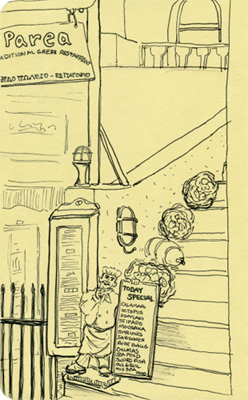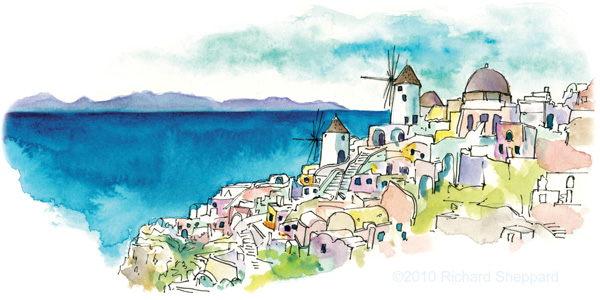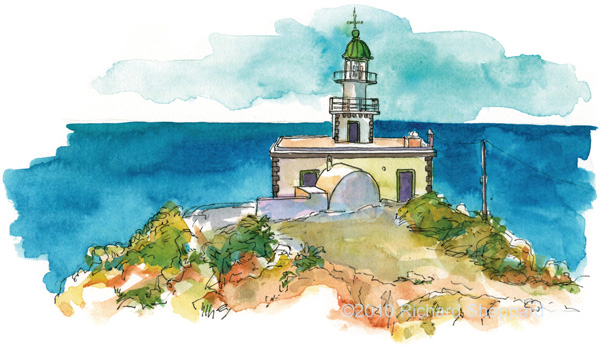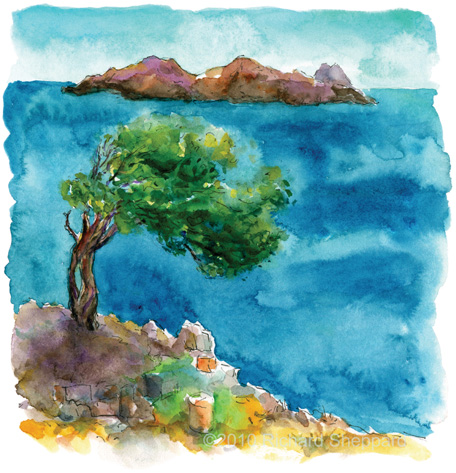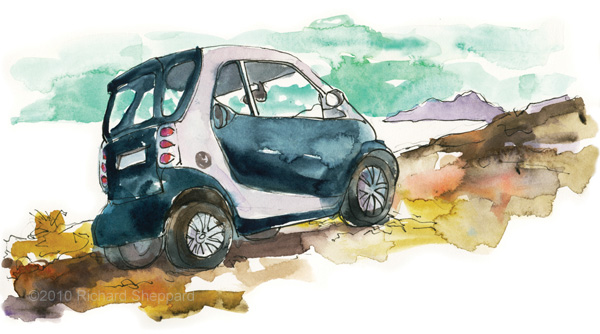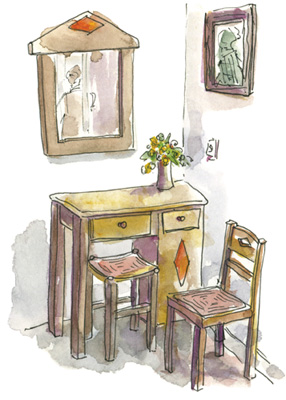 Upon our arrival on Mykonos, a middle-aged woman in a van picks us up and drives us to her hotel. Our room, actually two rooms with a kitchen, is spacious but situated along a main road that we hope won’t keep us up at night. Here I’ve drawn the desk located in one corner of the room. My dad can be seen in the reflection of the mirror above the desk.
Upon our arrival on Mykonos, a middle-aged woman in a van picks us up and drives us to her hotel. Our room, actually two rooms with a kitchen, is spacious but situated along a main road that we hope won’t keep us up at night. Here I’ve drawn the desk located in one corner of the room. My dad can be seen in the reflection of the mirror above the desk.
Category: Greece
Hydrofoil to Mykonos
Crepe Cafe
(Excerpt from my book, The Artist on the Road: Impressions of Greece)
This morning, while waiting to see if this afternoon’s hydrofoil to Mykonos will sail, we go to an outdoor cafe for chocolate crepes and Greek coffee. These are not your delicate French crepes, oh no. These are Greek crepes, thick, almost pancake-like, folded into quarters and oozing with chocolate sauce. The warm chocolaty goodness melts in my mouth. I work on a sketch of the shops across the street while still enjoying the last few bites of my crepe. Our waitress, gathering our plates, smiles at me, conveying her appreciation of my sketch.
Today I’m drawing a little differently than I have been. I appreciate the fact that I’m not telling too much and leaving the rest to the imagination. It’s as if I’m drawing just the important parts, only enough to describe the scene. My touch has also lightened, leaving space between lines and allowing the drawing to breathe. It’s really a type of vignetting, and I like the new style. I’ll have to work like this more often.
Restaurant Parea
I’m in the mood to draw something, anything, but with the windy weather, I think it’ll be impossible to draw outside. Yet in the hope of finding a sheltered spot, I go out with my sketchbook. Luckily, I find a semi sheltered spot at a taverna, purchase a Gyro, and find the best seat with a view. I draw another restaurant across the walkway called Parea in between bites of lunch. But its not long before the wind blows me back to the pension.
Oia, Santorini
After a leisurely stroll through Ioa to the far tip of the island, we walk beyond the whitewashed buildings and continue along a stone walkway that leads to the edge of a cliff. Climbing a set of stairs, we now stand among the ruins of the 13th century castle, Kasteli of Agios Nikolaos, built by Venetians to protect the island from pirates. During the time that the Venetians’ ruled the islands, it was christened “Santorini†after the Church of Santa Irene.
The old castle offers one of the island’s most spectacular views overlooking several other sepia-colored islands rising up from the cobalt-blue Aegean. Looking back, the pale, whitewashed colors of Oia spread out across the top of the caldera in contrast with the dark, rocky cliffs below. To the north, several prominent windmills rise above the city.
Another small note – although I was unaware at the time I painted this piece, the house that was used to film the old 80‘s movie “Summer Lovers†is at the bottom, toward the center of the painting. I happen to watch the movie again a few weeks ago just to see how Santorini has changed in the last nearly 30 years (yes, its almost been that long), and at one point, I paused the movie and noticed that my painting of Oia actually included part of the their house.
Santorini’s Lighthouse
(Excerpt from my book, The Artist on the Road: Impressions of Greece)
We hop into the car and drive west to the faros (lighthouse), located at the south-western tip of the island. We pull up and park just below the square base of the lighthouse with its green-domed tower pointing skyward. Built well over 100 years ago, it was originally fueled by petroleum with a lighthouse keeper attending the oil lamps and lenses, and keeping the clockwork mechanism wound. But in the 1980s, it was converted to electricity, and now an automated system handles these tasks.
Hoping for a better view, I follow a path that leads to the top of a small hill. From this perspective, the lighthouse sits at the horizon with the open sea stretching out in both directions. Small white caps rise and fall on the water animated by a breeze blowing from the west. I try to imagine the darkness the lighthouse faces every night. Being a nocturnal creature, the lighthouse is generally viewed as a warning to mariners, but beyond that, a lighthouse has an archetypal presence, and has a romantic, lonely quality that resonates deep within the human spirit. It’s as if it has its own purpose, one which keeps it searching the darkness night after night for someone lost and beyond its reach. Feeling alone and a bit lost myself, I climb back down the hill.
Ancient Thera, Santorini
(Excerpt from my book, The Artist on the Road: Impressions of Greece)
Ancient Thera has always been a windswept place, but today’s gentle breeze is a welcome change from yesterday’s weather. The ruins are spread along the northern side of the mountain, and thus, somewhat protected from southwestern wind. I find a sheltered place near a windswept tree and begin to paint. It seems an appropriate spot from which to describe this place.
The island of Santorini had been uninhabited since the volcano erupted circa 1600 BC and destroyed the island civilization. Then, according to Greek mythology, Kadmos, an ancestor of Oedipus, arrived here in 1400 BC while searching for his sister Europa and founded a colony.
Ancient Thera takes its name from Theras, a descendent of Kadmos and Oedipus, the king of Thebes who inadvertently killed his father and married his mother. Theras came here and was accepted as king because of his lineage.
Thera’s ruins are extensive and spread across the top of Messa Vouno. The center of the city was formed around its agora (about the size of a football field), and its temples, Stoa, and theatre were at the edge of the cliff, with homes along the interior.
After traversing the rest of the ruins, we descend the switchbacks and continue our tour around the island.
Exploring the Island of Santorini by Car
(Excerpt from my book, The Artist on the Road: Impressions of Greece)
Today, we’ll rent a car to explore the rest of the Island. Ancient Thera is the only archeological site open, since Akrotiri’s roof collapsed a couple of years ago. This is unfortunate because that’s where the wall paintings I love so much were unearthed. I’m also interested in seeing Oia, a city known for its spectacular views overlooking the caldera, but our first destination is Ancient Thera. It’s located near the village of Kamari, high atop the mountain Messa Vouno.
We drive southeast across the island, negotiating unmarked roads and up and down small hills. Even with the recent rains, the landscape looks bone dry. Scrubby brush and sun-bleached weeds only partially cover the arid, rocky soil. Off in the distance, Messa Vouno rises up from the landscape and guides us to our destination. But as we make our way up the mountain to the Ancient city of Thera, I discover it’s one of the most difficult, winding roads I’ve ever negotiated. Switchbacks snake us up the mountain and have an almost undriveable cobblestone surface. Adding to the difficulty, the road doesn’t have guardrails and is so narrow that it’s barely wide enough to pass. It’s a good thing we rented a tiny car or we could never make it up.
